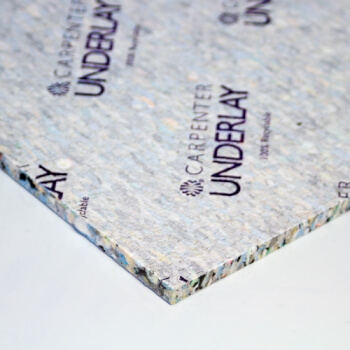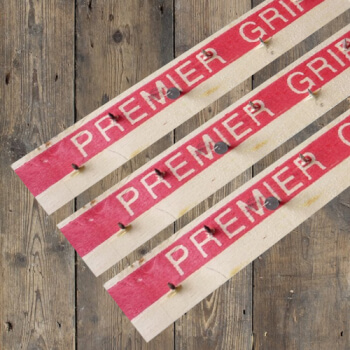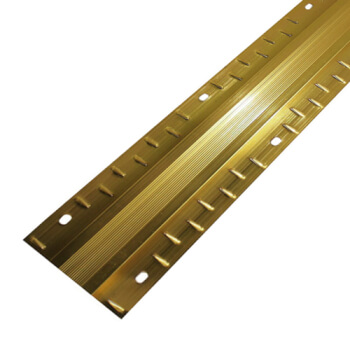How To Choose The Right Underlay
By Jim (24/10/2016)
Update September 2017:
We are now supplying Carpenter's Underlay in 4 different qualities - although we are still happy to recommend Ball and Young's underlay, Carpenter is of an even higher density so will last longer - a good investment for the home!
Hello again!
In a previous blog we covered how to choose your perfect carpet - but in many ways, underlay can be just as difficult! After all, with a carpet you can at least partially tell the quality by touch, but underlay is an unknown quantity - how do you know you’re getting something good?
Well, hopefully we can help to clarify the underlying truth of underlay!
1. What Is Underlay, And What Is It For?

Image: Ball & Young Contract Cloud 9 ©Designer Carpet Remnants
Most of us have heard of underlay - it seems pretty self-explanatory: something you lay under your carpet. But what actually is it?
It comes in several different types - more on that in a moment - but generally it is a slightly spongy, springy layer which separates the carpet from hard floor and adds some ‘give’ to what would otherwise be a hard surface.
Its primary function is to increase the lifespan of the carpet, because this springiness reduces the amount of pressure exerted on the carpet itself. This means that over several years the wear and tear will be significantly less and save money on replacements.
But that’s not all - underlay also functions as an insulator, warming the room by trapping heat (more on that later) and helps to absorb ambient noise. A good underlay can absorb up to 40 decibels of ‘impact sound’, reducing echo and generally making a room far less noisy. On top of all of this, is makes the carpet far more comfortable to walk on!
So, it is a good investment for many reasons, but just like carpet, the right underlay will depend on your needs. So let’s look at the different types...
2. Different Types of Underlay
Image © Designer Carpet Remnants
There are several different types of underlay, each with their own unique traits - here are the main ones you are likely to encounter...
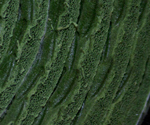
Sponge Rubber
The traditional underlay material, sponge rubber is a very good conductor (hence its use with underfloor heating, see below) and its weight makes it lie reliably flat on the ground.
It is also cheaper than many other types of underlay- however, it tends to lose its springiness faster and can go ‘dead’ after a long time in a high-traffic area.

Crumb Rubber
Crumb rubber underlay is made, principally, from recycled tyres - it is a similar material to what is used for children’s play areas.
It is ultra-durable and firm, keeping its resistance for a long time, but it tends to be quite expensive, almost twice the price of Polyurethane underlay.
Also, there are some concerns that there may be toxic or even carcinogenic chemicals present in the material. Of course, being under the carpet, it should cause too much of a problem, but it is worth mentioning just in case!
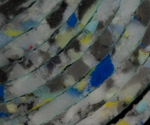
Polyurethane
Polyurethane (PU for short) is used in everything from glue to roller-skate wheels - the specific construction for underlay is recycled foam, shredded and bound together with adhesive.
It has many advantages - it's light, environmentally friendly, relatively cheap and ‘springs back’ far faster (and for far longer) than sponge rubber underlay. It is also an excellent insulator and sound absorber. However, because of it’s insulation properties it isn’t suitable to use with underfloor heating, except in special cases (see below).
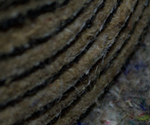 Felt
Felt
Felt underlay is particularly useful for fitting carpet which needs to be joined- the texture is very good at hiding the seams. For this reason, felt is often used for stately homes like those owned by the National Trust, as their carpets tend to be laid in sections. However, it has been shown to lose up to 50% of it’s thickness over its lifetime.
Brintons produce their own felt underlay - their ‘Brinfelt’ product is made with a combination of felt and crumb rubber, and has a very firm consistency - you can order a sample from their website.
There are some other combinations of materials, such as Crumbwool, made from recycled carpet by Anglo Recycling in association with Laneve™ (who we mentioned in a previous blog) but their properties have not been widely reported - yet.
We list four types of underlay on our website, all from Carpenter. These are all PU underlay and are guaranteed to last for the lifetime of the carpet.
3. Underlay for Natural Floorcoverings
Natural floorcoverings have many advantages and are becoming increasingly popular, however they also have their own unique considerations when it comes to fitting and - by extension- choosing an underlay.
This is because natural materials expand and contract with changing temperature, and so precautions need to be taken to ensure they don’t buckle after being fitted.

Image: Cosi 8mm ©Designer Carpet Remnants
Many natural floorcoverings have a latex backing which means they they can, in theory, be placed directly onto the floor, but as with conventional pile carpet, natural floorcovering will last longer if fitted with underlay.
Typically, they are glued directly to the underlay, which is then glued to the floor- this is known as the ‘double stick’ method.
Sponge rubber and felt (which are not really suitable for this process, as they will absorb glue; crumb rubber and polyurethane underlay are generally favoured. There are specific ‘double stick’ underlays - leading natural floorcovering manufacturer Crucial Trading recommend Duralay’s Durafit and Tredaire Technics.
Carpenter Prostep and Ultimate Living are also designed to work under natural flooring, but it is always best to consult your fitter as they will have their own preferences.
4. Underlay and Under-Floor Heating
Update May 2018:
NB: We now supply Carpenter 6mm Extrastep, an underlay designed specifically for use with underfloor heating - you can buy it in our Accessories Section
In our previous blog about choosing carpet we talked about tog rating, a measurement of the thermal resistance of a material. Most commonly used for things like sheets and duvets, a tog rating essentially tells us how good a material is at trapping heat. A material with a low tog value will allow heat energy to pass through, whereas one with a high tog value will resist it.
But what does this have to do with underlay?
Well, if you are considering using underfloor heating, then you will have to make sure that both your carpet and your underlay are suitable. Too high a tog value for either of them may cause problems - for example, the heating system will switch off prematurely, as the temperature under the carpet will be higher than the room due to the trapped heat.
The Carpet Foundation and the Underfloor Heating Manufacturers Association (UHMA) both agree that a heating system should operate effectively if your combined carpet and underlay have a tog value of 2.5 or less. Finding this combined value is quite straightforward - a good rule of thumb is to add the values of both carpet and underlay together, then subtract 1.

Image: Underfloor Heating ©WikiPedia
For example…
NB: We are using a Brintons’ carpet for this because they helpfully put the tog ratings of all their ranges on their website.
Not all carpet manufacturers list them but we can find them for you if required.
Say you wanted to carpet your floor using Brintons Bell Twist, which has a tog value of 1.23, with some Carpenter Perfect Living 8mm underlay, which has a tog value of 2.53.
So,Total tog rating = (1.23 + 2.53) - 1 = 2.76
This is little too high, so you will need to change either the carpet or the underlay. Like most people, you’ve become fairly attached to your choice of carpet, so you decide instead to switch to Carpenter Prostep underlay which has a tog of 2.07...
Total tog rating = (1.23 + 2.07) - 1 = 2.30
This combination is under 2.5 and so should be suitable for most underfloor heating.Of course, it is worth discussing arrangements with a heating engineer before making any big decisions, but this formula will give you a good start.
Although we have used polyurethane underlay in these examples, as mentioned before sponge rubber is actually preferred for this as it is a better conductor.
The company Ball & Young also manufacture several underlays specifically for underfloor heating, which we can provide for you if necessary.
5. Underlay and Felt Backed Carpet
You may have heard that some carpets, those with felt backing, don’t need an underlay, and can be placed directly on this floor.
This is technically true - they can be fitted without underlay, as the felt provides part of the ‘spring’’ that is traditionally given by underlay, making it more pleasant to walk on and reducing wear. However, that doesn’t mean that a felt-backed carpet won’t benefit from underlay.
You can usually get away with a thinner or softer underlay, but we would always recommend using it to keep the carpet looking and feeling its best.

Well, that’s it for now! We hope that this will help you when it comes to making the often overlooked (pardon the pun) decision on your underlay - and if you’re still confused or you need more advice, don’t hesitate to get in touch!
Enter your required size for our most accurate pricing and availability.









